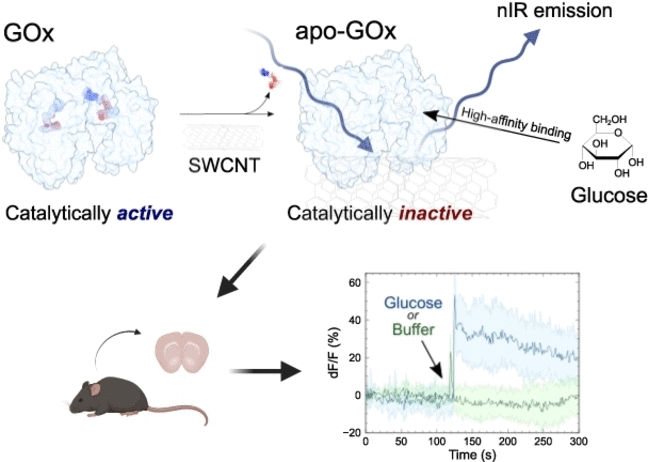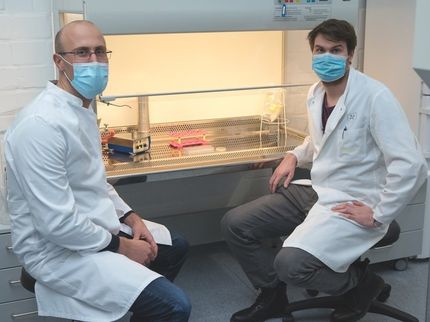Continuous Glucose Monitoring
Tissue-Integrated Sensitive Glucose Nanosenor Using Inactive Glucose Oxidase Enzyme
Monitoring glucose levels is one of the key elements in health monitoring. A research team has now developed a battery-independent fluorescent nanosensor based on single-wall carbon nanotubes and an inactive form of the enzyme glucose oxidase (GOx). Because the enzyme is not in its active form, the analyte is not consumed during the measurement, and continuous, reversible, and non-invasive bioimaging of glucose levels in body fluids and tissues is possible, the team reports in the journal Angewandte Chemie.

© Wiley-VCH
Blood glucose levels are typically measured using GOx-based electrochemical sensors. However, these sensors produce toxic hydrogen peroxide as a byproduct and, furthermore, require bulky electrical circuits and batteries, making it difficult to prepare implantable devices for continuous measurement. Tiny SWCNTs, on the other hand, can be integrated into tissues and provide bioimaging information: when excited by light, SWCNTs produce a near-infrared fluorescence signal that travels through tissue and can be easily recorded using non-invasive bioimaging techniques.
Unfortunately, making GOx-based SWCNT nanosensors is difficult because the most effective technology for loading molecules onto SWCNTs—sonication—essentially inactivates the GOx molecules. Now, Markita P. Landry and her research team at the University of California in Berkeley, USA, have disproved the assumption that GOx-based sensors require active GOx for successful glucose sensing. Using sonication, they prepared GOx-loaded SWCNT sensors that reliably, selectively, and sensitively detected glucose, as demonstrated for glucose measurements in serum, plasma, and mouse brain slices.
The researchers explained this surprising finding by the ability of the inactive GOx enzyme to bind glucose without converting it. Binding alone was sufficient to modulate the fluorescence signal. To be completely independent of GOx activity, the researchers also constructed a GOx enzyme that even lacked the reactive group for glucose conversion. The resulting apo-GOx-SWCNT sensor detected glucose in body fluids and mouse brain slices as reliably as the original conjugate of SWCNT and natural GOx.
The researchers point out that the use of inactive GOx molecules has major advantages. For example, the manufacturing process of the GOx-SWCNT nanosensors can be simplified by using sonication as an effective preparation step. In addition, as the analyte is not consumed by the enzyme reaction, no toxic byproducts are produced, and the measurements are intrinsically reversible, allowing for non-invasive continuous glucose monitoring in tissue fluids.
Original publication
Most read news
Original publication
Shoichi Nishitani, Tiffany Tran, Andrew Puglise, Sounghyun Yang, Markita P. Landry; "Engineered Glucose Oxidase‐Carbon Nanotube Conjugates for Tissue‐Translatable Glucose Nanosensors"; Angewandte Chemie International Edition, 2023-11-30
Topics
Organizations
Other news from the department science

Get the life science industry in your inbox
By submitting this form you agree that LUMITOS AG will send you the newsletter(s) selected above by email. Your data will not be passed on to third parties. Your data will be stored and processed in accordance with our data protection regulations. LUMITOS may contact you by email for the purpose of advertising or market and opinion surveys. You can revoke your consent at any time without giving reasons to LUMITOS AG, Ernst-Augustin-Str. 2, 12489 Berlin, Germany or by e-mail at revoke@lumitos.com with effect for the future. In addition, each email contains a link to unsubscribe from the corresponding newsletter.





















































